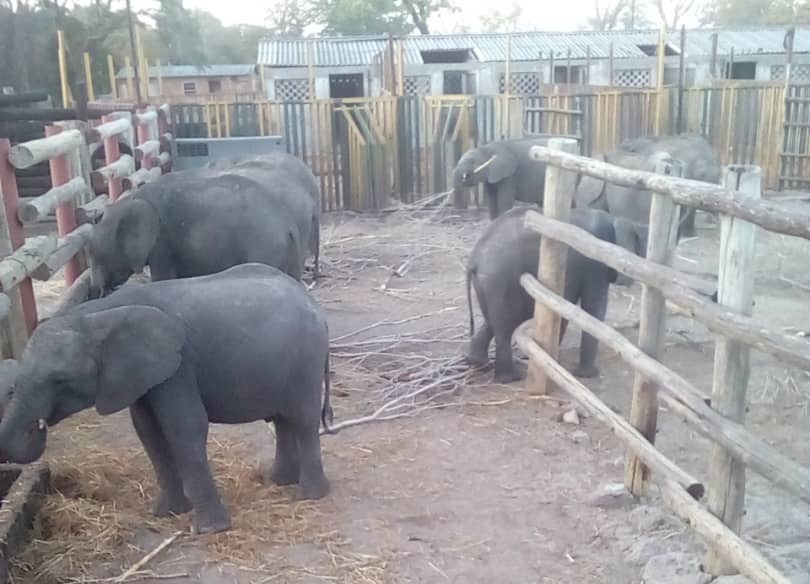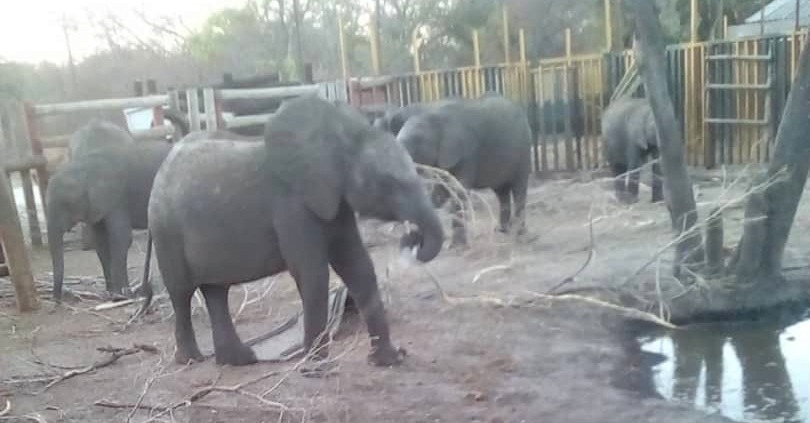
OPINION POST by Audrey Delsink (Wildlife Director, Human Society International/Africa), Keith Lindsay (Collaborating Researcher, Amboseli Trust for Elephants), Adam Cruise (Journalist) and Ross Harvey (Independent Economist)
Despite local and international protestation, Zimbabwean authorities have gone ahead with exporting baby elephants from the country. In a clandestine act, thirty-two elephants were moved from their holding pens at Hwange National Park during the night of the 23rd of October and flown out of Victoria Falls on a Saudi Arabian Airlines Cargo plane, Saudia.
The other five (of the thirty-seven originally captured elephants) were deemed too unhealthy to travel, which in itself is an indictment on the Zimbabwean authorities for their inhumane handling of the situation. On several occasions, the Zimbabwean National Society for the Prevention of Cruelty to Animals (ZNSPCA) was denied access to the holding facilities, further demonstrating the lack of transparency surrounding this matter. Coincidentally – or more likely, purposefully – the elephants were flown out of the country on the same day as the ZNSPCA filed an urgent chamber application to gain access to the boma facility to assess the elephants’ condition following several delays. A legal case is currently before the courts, which argues that the export violates Zimbabwe’s national legislation. The case is yet to be heard by a judge. Therefore, the Zimbabwean Parks Authority (ZimParks’) decision to push ahead with the export demonstrates its distaste for accountability and the rule of law. The complainants are Zimbabwean NGOs whose members have shown bravery in standing up to a brutal authoritarian regime. To label them as being in the pockets of ‘animal rights’ organisations is as callous as it is inaccurate.
The young elephants were cruelly separated from their families nearly a year ago and have been held in captivity since then. They have now been sold to China, presumably to safari parks near Shanghai, the apparent port of arrival according to the cargo carrier’s flight path. As ZimParks has not provided any documentation, the final destination of the elephants cannot be confirmed, though it is alleged that the group will be further split into 12 smaller groups. In line with past form, the extraction of cash from the country’s remaining natural heritage is thought to go towards paying off debt owed to China or paying soldiers’ salaries (or both). China should know better, as it has recently initiated an ‘Ecological Civilisation’ programme, which inter alia discourages the purchase of ivory. To be consistent, this programme should be extended to discourage the viewing of wild animals in unnatural captivity, especially elephants. To their credit, Chinese activists have reacted with outrage at the new imports.

A recent fundraising event for wildlife by the Sino-Zim Wildlife Foundation demonstrates the deep tie between Zimbabwe and China. Headed by infamous wildlife trader Li Song and ZimParks, and supported by presentations from the Director-General and the Permanent Secretary of the Minister of Environment, Tourism and Hospitality Industry, with a “donations” slot, this event, held on the 29th October, is a clear attempt to persuade the world that these sales somehow benefit wildlife conservation.
It is well within the bounds of conventional science to assert that this exercise in terrifying, brutal capture followed by decades in sterile conditions of captivity is a fate worse than death, as the affected elephants demonstrably suffer post-traumatic stress disorder. Elephants are highly social beings who require interaction with other elephant companions, large amounts of foraging and roaming space, environmental richness and freedom of choice. Human removal of any of these factors is tantamount to cruelty and abuse.
For this reason, members to the Convention on International Trade in Endangered Species of Wild Fauna and Flora (CITES) – at the 18th Conference of the Parties (CoP18) in Geneva in August this year – overwhelmingly decided that African elephants may no longer be removed from their natural or historic range except under extraordinary circumstances. This is the first time that the convention has recognised the importance of welfare in conservation. Despite detractors – mostly proponents of consumptive ‘sustainable use’ or ‘harvesting’ of wildlife – wailing that the decision reflects an ‘animal rightist’ agenda, there is no science that positively supports the extraction of a range of animals from their functional roles in natural ecosystems, akin to removing piece after piece from a jigsaw puzzle, or Jenga tower. There is also increasing legal precedent for recognising the importance of welfare as integral to conservation. In South Africa – still a hotbed for consumptive use and crude utilitarianism – the Constitutional Court ruled in 2016 that conservation and welfare are intertwined values. On the back of this ruling, the Gauteng provincial High Court ruled in August this year – shortly prior to CoP18 – that the sale of lion bones out of the country is illegal because it violates welfare considerations.

CITES Resolutions technically only come into effect 90 days from the end of a CoP, although this point is a ‘grey area’; sections of Resolutions that are not under Recommendation may come into effect immediately. In addition, the 90-day period is intended to allow time for States to confirm that national legislation or regulations are in line with the international ruling; not to allow a country to sell off its existing ‘stock’. Clearly, Zimbabwe rushed to sell its elephants before three months passed after CoP18 (26 November 2019), in direct violation of the spirit of the Convention. Being arguably within one’s ‘sovereign rights’ exhibits a mercenary mentality that undermines conservation. In this particular case, it is also immoral and obsolete.
A handful of southern African nations are crying foul regarding the CITES decision, especially because it complements another decision to maintain the international moratorium on the ivory trade. Rowan Martin has written, for instance, that CITES ‘does wildlife conservation no favours’. CITES clearly has its difficulties, but Martin’s misgivings have little to do with the governance and enforcement challenges facing the protection of species from extinction through over-exploitation. His is a philosophical misgiving, in which he axiomatically rejects any ruling that questions his predisposition towards consumptive use, something he deems to be a country’s ‘sovereign right’, whether or not it affects the survival of a species in other, even most, sovereign States across its geographical range.
It is this presuppositional commitment to consumptive use on which ZimParks has justified the sale of baby elephants to China. Hiding behind ‘sovereign rights’, the argument is that Zimbabwe answers to no one and can do with its elephants as it pleases. It further hides behind the view that there are ‘too many elephants’ which have exceeded the country’s ‘carrying capacity.’
These views must be debunked.
First, there is no such thing, scientifically, as ‘too many elephants.’ The concept is predicated on an agricultural notion that views national parks as farms that have a static ‘carrying capacity’, a term that has been applied to large mammals most commonly in the context of commercial livestock production. Martin’s perspective exhibits an aesthetic commitment to a utopian state of eternally attractive woodlands (normally with an idolisation of a perfect number of large trees). Almost any number of elephants, which forage naturally on woody plants, may thus be ignorantly viewed as marauding tree destroyers. Fluctuations of animal and tree populations, in the face of droughts, deluges or other disturbances are the prevailing drivers of highly variable semi-arid savannah ecosystems. Animal populations self-regulate in relation to their food supply through births and deaths, or dispersal. There is no basis for a fixed ‘carrying capacity’ for elephants, except in the mind of man.
ZimParks, confusingly, initially stated that the exports were not happening and that there was nothing secretive about it. They nonetheless took the opportunity to point out that the drought had killed 55 elephants, evidence somehow that there were tens of thousands ‘too many’ of them. To state the obvious, none of this adds up. As already noted, droughts are part of natural cycles that fluctuate, now exacerbated to greater extremes by climate change. Elephants, through their foraging, can change landscapes as ecosystem engineers, a keystone species. Their role is pivotal and irreplaceable. Left to disperse in large, dynamic ecosystems, they produce patch heterogeneity – uneven impact across a landscape – that keeps the system healthy.
Managing a dynamic ecosystem as if it is a farm necessarily obstructs the system’s ability to function through ecological processes. Culling, hunting and removal of baby elephants are justified as necessary management interventions under the premise that there are ‘too many’, but culling has been exposed, even by its initial proponents, as a cruel mistake. Hunting has genetically selective effects by removing the biggest and best animals and creates extensive social and ecological problems. Removing baby elephants from their families, in which they would be nurtured and taught life skills, is abhorrent. The idea that the revenue accruing from the sales will somehow be ploughed back into conservation is a deception.
Second, the ‘sovereign rights’ clarion call does not make biological sense. At least 76% of Africa’s elephants are shared across borders. The solutions to southern Africa’s conservation problems are not to be found in trying to generate short-term and unsustainable revenue from hunting and exporting the last remnants of our shared natural heritage. Rather, the solutions lie in better, regionally integrated land-use planning. Movement corridors that allow elephants to reduce local numbers and avoid conflict with people have been identified in, for example, Botswana, but these need to be actively protected by genuine community co-ownership.
Paper parks like the Kavango Zambezi Transfrontier Conservation Area (KAZA) are struggling to achieve relevance because the political will to work together across its five countries is lacking at important ministerial levels. Meanwhile, efforts at the grassroots level to involve local communities both within and across borders in ecotourism value chains and conservation-compatible agriculture have greater potential for improving regional conservation outcomes and rural economic development. Blindly supporting ‘consumptive use’ of wild species on the grounds that a nation somehow ‘owns’ its elephants or that there are ‘too many’ crowds out the urgency of building viable alternatives to the status quo. Rural communities are hardly served by exporting, culling or hunting elephants. They are served by carefully crafted plans that recognise the biological and economic needs of both elephants and people, and put money straight into citizens’ pockets, particularly for women.
Zimbabwe’s decision to undermine a significant CITES resolution is indicative of the contempt it has for conservation. Equally, China’s decision to import the elephants is a violation of its own efforts to build an ‘Ecological Civilisation’. Both countries are member parties to CITES and they would do well to observe the spirit of its collective decision-making process. Instead of dismissing decisions that don’t go their way as evidence that ‘animal rights extremists’ have somehow manipulated the CoP, they should respect the independent minds of two-thirds of the Parties present. Crude utilitarianism – the willingness to sacrifice individual animals to achieve an evasive aesthetically-defined ‘carrying capacity’ – has no place in modern conservation that should strive to be both effective and ethical. We have to do better; we can do better.
To comment on this story: Login (or sign up) to our app here - it's a troll-free safe place 🙂.![]()






